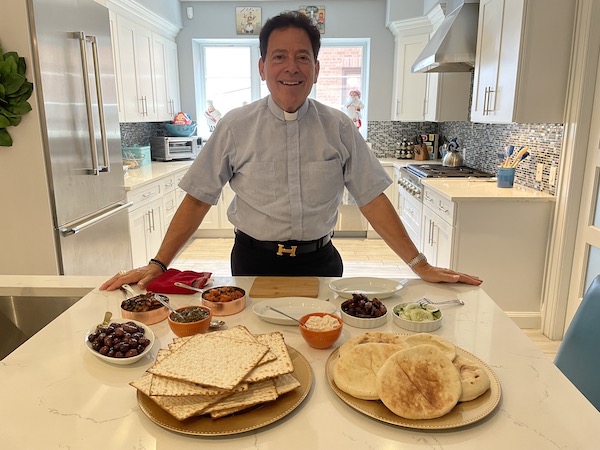
WILLIAMSBURG — In all likelihood, it wasn’t a gourmet. Yet it was probably the most important dinner ever eaten in the history of mankind.
The Last Supper, the Passover meal Jesus Christ and the Apostles consumed in Jerusalem in the hours before Jesus was betrayed by Judas, turned over to the Romans and crucified, is meaningful to Catholics and Christians because it is part of the foundation of the faith.
But while the significance of the Last Supper is well known and has been immortalized in artworks like Leonardo DiVinci’s famous painting, little is known about the food that was served there — aside from bread and wine.
Msgr. Jamie Gigantiello, pastor of the Shrine Church of Our Lady of Mount Carmel in Williamsburg, who was a chef before entering the priesthood, gamely made an attempt to recreate the dishes of the Last Supper and invited The Tablet to have a taste.On the table before him in his rectory kitchen were several dishes filled with lamb stew, beans, bread, olives, fish, cucumbers and dates. Nearby, there was a bottle of wine. One tidbit Msgr. Gigantiello shared: “In those days, wine was consumed like we would consume water,” he said.
“This menu is what I have researched. Is it accurate? I don’t know. But from what we hear, the Passover meal was eaten by Jesus and the Apostles and of course like any cuisine, they would have been the foods of the region and in the Middle East at that time,” he explained.
It made perfect sense that the Last Supper was a Passover meal, Msgr. Gigantiello explained, because Jesus was Jewish and he and the Apostles would have most probably adhered to Jewish traditions.
“One of the things we know that they did have was lamb,” Msgr. Gigantiello said. “But they wouldn’t eat leg of lamb or lamb chops like we eat today. It probably would have been stewed in a pot. And that’s what we have here.”
Beans and olives were on the table for a reason, he explained. “Beans were very popular at that time, so we have a bean stew,” he said. There was a healthy serving of olives. Msgr. Gigantiello noted that olive trees are featured prominently in Scripture.
Msgr. Gigantiello admitted that he improvised a little bit when it came to the food preparation. “Of course it’s been 2,000 years, so food has evolved, obviously. Traditions have changed and things have been added and things have been taken out,” he said.
As an example, he pointed to the bread on the table — pita bread and matzos. “Of course unleavened bread was one of the staples of the Last Supper. We eat matzos, but in those times they probably were eating some form of pita bread,” he said.
Msgr. Gigantiello prepared a fish salad using white fish and mayonnaise, something that would probably not have been at the Last Supper. However, he wanted something that was in the same food group. “They used fish at the time. And here’s a fish salad that’s very common today. Now of course, in those days they would not have had dairy, especially with fish. I would say that they probably had a fish stew or a fish made with different spices,” he said.
For the most part, his menu closely matched the findings of two Italian archeologists, Generoso Urciuoli and Marta Berogno, who published a 2016 book, “Jerusalem: The Last Supper,” in which they outlined their research into the types of foods that were likely consumed by Jesus and the Apostles.
They built their research on Biblical texts, Jewish writings, historical data about ancient Romans and archaeological information on the foods common to the region around the time Jesus was alive.
The two most important food items at the Last Supper were the bread and wine, simple items but deeply meaningful. “And if you look at the life of Christ, everything was simple and he came among the simplest of the people,” Msgr. Gigantiello said.
Even though he enjoyed preparing the dishes, Msgr. Gigantiello said it reminded him that the significance of the Last Supper goes far beyond food. “What happened there was more important than what was consumed there,” he added.
